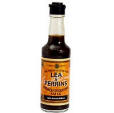Worcestershire Sauce
Information, history and recipes about
Worcestershire Sauce
Â
Â
Â
Â
Origin
and History of Worcestershire Sauce
Â
 Although
many of us think of Worcestershire Sauce as being very English, it�s origins are
firmly entrenched in India. In 1835, an English Lord, Lord Sandy, who hailed
from the county of Worcestershire in England, commissioned a pair of chemists,
John Lea and William Perrins, to reproduce a sauce he had sampled whilst he was
in India. Why he should engage Chemists rather than cooks will probably remain a
mystery, but that�s certainly what he did. Although
many of us think of Worcestershire Sauce as being very English, it�s origins are
firmly entrenched in India. In 1835, an English Lord, Lord Sandy, who hailed
from the county of Worcestershire in England, commissioned a pair of chemists,
John Lea and William Perrins, to reproduce a sauce he had sampled whilst he was
in India. Why he should engage Chemists rather than cooks will probably remain a
mystery, but that�s certainly what he did.
They accepted the commission, however after working on the concoction, the end
result was anything but pleasant and they finally gave up, leaving the brew in a
cellar. They came across it some two years later but before discarding it, they
decided to taste it again, probably to reinforce what a hash they made of it.
However, much to their surprise, it had improved and matured, a bit like a fine
wine or balsamic vinegar. It had taken on an aromatic smell with an unusual
piquant taste. There � the original Lea & Perrins Worcestershire Sauce came into
being.
We can only assume these chemists were also incredible marketers as before long
Worcestershire sauce found itself on passenger ships, hotel dining rooms and
restaurants the former being instrumental in spreading the �Worcestershire Sauce
Word� all over the globe and its popularity remains in many cuisines worldwide.
To put it firmly in its rightful place, mention should be made of the fact that
it�s been commercially available for over 165 years�.that�s 45 years longer than
Ketchup. So good was the original that there are now over 100 different brands
available.
Â
Â
Production and Ingredients of Worcestershire Sauce
Â
Although there are many different brands available, here we will
deal with the original and �authentic� brand so we must point out that other
brands will vary both in production methods and ingredients.
This condiment should properly be considered a worldwide ingredient as it
contains many ingredients which aren�t native to England such as tamarinds from
India, chilli peppers from Africa and anchovies from Italy. To be considered
authentic, it should also contain (among other things) vinegar, molasses,
cloves, garlic and onion.
Although the original recipe is apparently a closely guarded secret, we do know
that the ingredients are fermented in vinegar over a long period of time and
once matured the mixture is strained into wooden casks and left again to further
mature. This is reminiscent of the way Balsamic vinegar is processed. Once fully
matured, the sauce is strained again although some solids are always left in
which gives the sauce its particular characteristics. So you should always shake
the bottle before every use.
Some differences between �authentic� Worcestershire sauce and would-be imitators
are only fresh onion, garlic and shallots are used - not cooked or dried vegetables. Also
the sauce should not be �cooked� at any stage in the maturing process but rather
left to age for a long time, like wine. Furthermore, no colourings, such as caramel
should be added as an authentic Worcestershire sauce relies on the molasses for
its dark colour.
Â
Worcestershire sauce in cooking
Â
Where to start? Soups, stews, meats, fish, poultry, cheese
dishes, vegetable dishes, marinades, sauces, gravies and dressings can all
be enhanced with varying amounts of Worcestershire Sauce. If you�re not familiar
with its use, then just try small amounts at first: no more than �Â
teaspoon until you�re well versed with its taste.
Â
The only drawback, if one can call it that, is that it contains anchovies and so
is unsuitable for vegetarians. Some brands may also contain gluten products so
always check the label.
Â
Below is a selection of dishes using this wonderful condiment. More
Worcestershire Sauce recipes can be found using the search
form.
Happy Cooking!
|
|